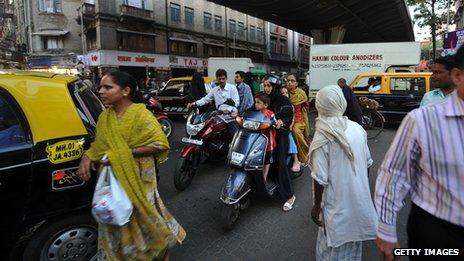Controlling Mumbai's traffic
- Published

About 450 new vehicles are registered every day in Mumbai
The streets of Mumbai are seldom quiet. Day or night they echo to the sound of revving cars, rumbling lorries and the angry-wasp buzz of auto rickshaws. And then there are the horns.
Traffic here is, to put it mildly, pretty appalling. In a city of 18 million inhabitants there are 1.8 million motor vehicles. The number is growing every day as more drivers take to the roads and frankly, there isn't enough road to go around.
Mumbai's problems are characteristic of a new breed of fast growing megacities where populations are measured not just in millions, but in tens of millions and growing rapidly.
So can cutting-edge technology provide a solution to prevent the entire system grinding to a halt?
Mumbai madness
On the face of it things don't look too promising.
"It's like hop-scotching in a minefield," says Hormazd Sorabjee, as he expertly guides us through the chaos. "It's not just the traffic, it's the road users. Everyone seems to use the road. You've got bikes, you've got ox carts, bullock carts. It really is quite a challenge driving in Mumbai."
Hormazd is editor of Autocar India, a man who spends much of his time taking on the city traffic, he blames a fundamental lack of infrastructure for the city's problems.
In recent years rural dwellers have been flocking to India's commercial capital hoping to take advantage of rapid economic growth.
Autocar India's Hormazd Sorabjee: 'Driving in Mumbai is like playing hopscotch in a minefield'
At the same time the city's middle classes have been expanding and as people have been getting richer so the number of cars has been multiplying.
Mumbai (Bombay) does have an extensive public transport network which nearly 90% of the city's commuters still use but it is bursting at the seams.
The crush in Mumbai's rush-hour trains is so bad that increasingly, it seems, those who can afford to do so would rather travel by car.
"It's my job to try and keep the traffic moving," says Vivek Phansalkar, the joint commissioner of Mumbai's traffic police.
"Given the volumes that we have in Mumbai, both of the population as well as the vehicles numbers it's an enormous task. We have about 450 new vehicles being registered every day."
So could modern technology make Mr Phansalkar's job any easier?
New systems, new solutions
With support from the World Bank, the city recently invested in a new traffic management system.
Overseen by a control centre in police headquarters, it allows officers to monitor traffic flows at key junctions via a network of cameras and sensors and adjust signals when necessary to help prevent snarl-ups.
Pushing a button in the control centre can make a traffic light at a distant junction turn from red to green or vice versa.
It is a relatively simple system and has proved quite effective in easing the pain of Mumbai's ever-present jams, but it certainly hasn't eradicated them.
So what about more radical technologies?
In Europe and America, in universities and in carmakers' research and development laboratories a great deal of time and effort is being put into the development of driverless cars.
Computer-controlled cars can travel closer together than machines driven by humans- so more can be fitted onto the road at any one time.
Those cars could also be made to communicate with one another passing on real-time information about traffic conditions and choosing their routes accordingly. They could even synchronise their movements if needed.
Driverless cars
Automated cars could also be made to work as driverless taxis, picking people up at their doors and dropping them off at their destinations meaning fewer cars on the road.

But would it work in the relative chaos of a developing megacity like Mumbai?
"I really don't think any robot car would survive here," chuckles Mr Sorabjee.
"I'm not sure how a robot car would respond to a motorcyclist coming straight towards it on the wrong side of the road. I don't know how you could programme it to deal with that."
And then there's the question of cost.
"This is a very cost-conscious market," says Mr Sorabjee. "So any technology has to be cost effective. If it led to lower running costs, that would be the biggest draw for them to go for a new technology."
It's unlikely that driverless cars would be all that cheap, to begin with at least. But that does not mean the cost of the technology will not come down quickly as it develops.
"It's certainly not a one size fits all solution," admits Sven Beiker, the head of the Center for Automotive Research at Stanford University in California and a leading expert on autonomous vehicles.
Leapfrogging technology
He thinks there is scope for a great leap forward and that developing countries could act more quickly than developed nations.
"It depends what kind of megacity you're talking about," he says.
"Some are relatively rich and they are embracing new technology very quickly, they've kind of leapfrogged landline telephones, for example, going straight to cell phones.
"The same might be possible for the infrastructure needed for automobiles."
He thinks it's possible that emerging megacities could see the benefits of driverless technology and take steps to encourage it by providing dedicated traffic lanes for example.
Picking your way through Mumbai's traffic, past ancient hand-painted Padmini taxis, past bullock carts and past hordes of those buzzing auto rickshaws, such a technological revolution looks a long way off.
But that does not mean it could not happen. The development of Bangalore as a leading IT hub shows that India is not afraid of embracing new technology and as its economy grows, the incentive for keeping its commercial capital moving is growing every day.